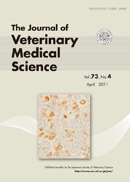Volume 73, Issue 4
April
Displaying 1-25 of 25 articles from this issue
- |<
- <
- 1
- >
- >|
Anatomy
-
Article type: FULL PAPER
2011Volume 73Issue 4 Pages 423-430
Published: 2011
Released on J-STAGE: April 28, 2011
Advance online publication: November 05, 2010Download PDF (1065K) -
Article type: FULL PAPER
2011Volume 73Issue 4 Pages 439-445
Published: 2011
Released on J-STAGE: April 28, 2011
Advance online publication: November 24, 2010Download PDF (719K) -
Article type: FULL PAPER
2011Volume 73Issue 4 Pages 447-452
Published: 2011
Released on J-STAGE: April 28, 2011
Advance online publication: November 26, 2010Download PDF (799K) -
Article type: NOTE
2011Volume 73Issue 4 Pages 475-477
Published: 2011
Released on J-STAGE: April 28, 2011
Advance online publication: November 11, 2010Download PDF (655K)
Internal Medicine
-
Article type: NOTE
2011Volume 73Issue 4 Pages 459-462
Published: 2011
Released on J-STAGE: April 28, 2011
Advance online publication: November 05, 2010Download PDF (932K) -
Article type: NOTE
2011Volume 73Issue 4 Pages 517-520
Published: 2011
Released on J-STAGE: April 28, 2011
Advance online publication: December 06, 2010Download PDF (609K) -
Article type: NOTE
2011Volume 73Issue 4 Pages 527-530
Published: 2011
Released on J-STAGE: April 28, 2011
Advance online publication: December 06, 2010Download PDF (658K)
Laboratory Animal Science
-
Article type: NOTE
2011Volume 73Issue 4 Pages 501-505
Published: 2011
Released on J-STAGE: April 28, 2011
Advance online publication: November 26, 2010Download PDF (617K)
Parasitology
-
Article type: NOTE
2011Volume 73Issue 4 Pages 511-516
Published: 2011
Released on J-STAGE: April 28, 2011
Advance online publication: December 04, 2010Download PDF (801K)
Pathology
-
Article type: NOTE
2011Volume 73Issue 4 Pages 467-470
Published: 2011
Released on J-STAGE: April 28, 2011
Advance online publication: November 05, 2010Download PDF (778K)
Pharmacology
-
Article type: FULL PAPER
2011Volume 73Issue 4 Pages 453-458
Published: 2011
Released on J-STAGE: April 28, 2011
Advance online publication: December 06, 2010Download PDF (638K) -
Article type: NOTE
2011Volume 73Issue 4 Pages 463-466
Published: 2011
Released on J-STAGE: April 28, 2011
Advance online publication: November 05, 2010Download PDF (550K) -
Article type: NOTE
2011Volume 73Issue 4 Pages 487-490
Published: 2011
Released on J-STAGE: April 28, 2011
Advance online publication: November 19, 2010Download PDF (547K)
Physiology
-
Article type: NOTE
2011Volume 73Issue 4 Pages 471-474
Published: 2011
Released on J-STAGE: April 28, 2011
Advance online publication: November 10, 2010Download PDF (501K) -
Article type: NOTE
2011Volume 73Issue 4 Pages 495-499
Published: 2011
Released on J-STAGE: April 28, 2011
Advance online publication: November 26, 2010Download PDF (748K)
Public Health
-
Article type: NOTE
2011Volume 73Issue 4 Pages 507-510
Published: 2011
Released on J-STAGE: April 28, 2011
Advance online publication: December 01, 2010Download PDF (651K)
Surgery
-
Article type: FULL PAPER
2011Volume 73Issue 4 Pages 431-438
Published: 2011
Released on J-STAGE: April 28, 2011
Advance online publication: November 17, 2010Download PDF (951K)
Virology
-
Article type: NOTE
2011Volume 73Issue 4 Pages 479-482
Published: 2011
Released on J-STAGE: April 28, 2011
Advance online publication: November 19, 2010Download PDF (524K) -
Article type: NOTE
2011Volume 73Issue 4 Pages 483-485
Published: 2011
Released on J-STAGE: April 28, 2011
Advance online publication: November 19, 2010Download PDF (483K) -
Article type: NOTE
2011Volume 73Issue 4 Pages 491-494
Published: 2011
Released on J-STAGE: April 28, 2011
Advance online publication: November 24, 2010Download PDF (570K) -
Article type: NOTE
2011Volume 73Issue 4 Pages 521-525
Published: 2011
Released on J-STAGE: April 28, 2011
Advance online publication: December 06, 2010Download PDF (549K) -
Article type: NOTE
2011Volume 73Issue 4 Pages 531-534
Published: 2011
Released on J-STAGE: April 28, 2011
Advance online publication: December 06, 2010Download PDF (825K) -
Article type: NOTE
2011Volume 73Issue 4 Pages 535-539
Published: 2011
Released on J-STAGE: April 28, 2011
Advance online publication: December 06, 2010Download PDF (505K) -
Article type: NOTE
2011Volume 73Issue 4 Pages 541-544
Published: 2011
Released on J-STAGE: April 28, 2011
Advance online publication: December 07, 2010Download PDF (501K) -
Article type: NOTE
2011Volume 73Issue 4 Pages 545-548
Published: 2011
Released on J-STAGE: April 28, 2011
Advance online publication: December 08, 2010Download PDF (503K)
- |<
- <
- 1
- >
- >|
